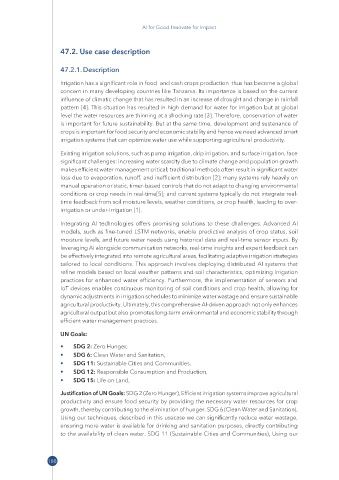Page 204 - AI for Good-Innovate for Impact Final Report 2024
P. 204
AI for Good-Innovate for Impact
47�2� Use case description
47�2�1� Description
Irrigation has a significant role in food and cash crops production thus has become a global
concern in many developing countries like Tanzania. Its importance is based on the current
influence of climatic change that has resulted in an increase of drought and change in rainfall
pattern [4]. This situation has resulted in high demand for water for irrigation but at global
level the water resources are thinning at a shocking rate [3]. Therefore, conservation of water
is important for future sustainability. But at the same time, development and sustenance of
crops is important for food security and economic stability and hence we need advanced smart
irrigation systems that can optimize water use while supporting agricultural productivity.
Existing irrigation solutions, such as pump irrigation, drip irrigation, and surface irrigation, face
significant challenges: increasing water scarcity due to climate change and population growth
makes efficient water management critical; traditional methods often result in significant water
loss due to evaporation, runoff, and inefficient distribution [2]; many systems rely heavily on
manual operation or static, timer-based controls that do not adapt to changing environmental
conditions or crop needs in real-time[5]; and current systems typically do not integrate real-
time feedback from soil moisture levels, weather conditions, or crop health, leading to over-
irrigation or under-irrigation [1].
Integrating AI technologies offers promising solutions to these challenges. Advanced AI
models, such as fine-tuned LSTM networks, enable predictive analysis of crop status, soil
moisture levels, and future water needs using historical data and real-time sensor inputs. By
leveraging AI alongside communication networks, real-time insights and expert feedback can
be effectively integrated into remote agricultural areas, facilitating adaptive irrigation strategies
tailored to local conditions. This approach involves deploying distributed AI systems that
refine models based on local weather patterns and soil characteristics, optimizing irrigation
practices for enhanced water efficiency. Furthermore, the implementation of sensors and
IoT devices enables continuous monitoring of soil conditions and crop health, allowing for
dynamic adjustments in irrigation schedules to minimize water wastage and ensure sustainable
agricultural productivity. Ultimately, this comprehensive AI-driven approach not only enhances
agricultural output but also promotes long-term environmental and economic stability through
efficient water management practices.
UN Goals:
• SDG 2: Zero Hunger,
• SDG 6: Clean Water and Sanitation,
• SDG 11: Sustainable Cities and Communities,
• SDG 12: Responsible Consumption and Production,
• SDG 15: Life on Land,
Justification of UN Goals: SDG 2 (Zero Hunger), Efficient irrigation systems improve agricultural
productivity and ensure food security by providing the necessary water resources for crop
growth, thereby contributing to the elimination of hunger. SDG 6 (Clean Water and Sanitation),
Using our techniques, described in this usecase we can significantly reduce water wastage,
ensuring more water is available for drinking and sanitation purposes, directly contributing
to the availability of clean water. SDG 11 (Sustainable Cities and Communities), Using our
188

